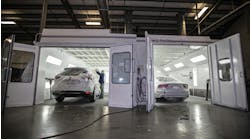I am sure you have seen or experienced the frowns when someone (maybe yourself) at a reception or party double dips their chip, vegetables or chicken in the sauces available. At my house my kids even set the ground rules when a bag of chips are opened at the table by stating before anyone grabs the chips, “No double dipping!”
As I have stated in my last two columns, let's focus on the real issues and not believe that an insurer-mandated software program is the solution. In my last columns, the key issue with used parts is their "real" condition, and that it is completely hidden from the vehicle owner. But why has this become such a huge problem, and what does double dipping have to do with all this? Believe it or not, double dipping is probably one of the key root causes for the present condition of used parts and the inefficiencies it has added when procuring used parts, not the system in which we use to order them.
In the distant past, it was not uncommon for salvage value purchase agreements ranging from 11 percent to 22 percent of the actual cash value (ACV) for the totaled vehicles. These vehicles then entered into the supply chain at a much larger percentage, even though there was still a level of “rebuildables” that were not “parted” out. Today it is much different.
Today, the Internet bidding process has opened a new lucrative business opportunity for insurers that didn’t exist in the past, and they are taking full advantage of it. However, it is causing issues with the parts that are left and available for the supply chain. This has quickly turned the “total loss” department of an insurance company into a formidable profit center, and one of the key drivers in whether a vehicle is going to be repaired today or totaled. This is simply double dipping, and is a key root cause of many of the issues that the repair industry faces every day when being held to requirements set by insurers for usage of used parts, or mandated parts procurement programs.
Today, talking with many recyclers, the purchase prices paid by foreign buyers who simply rebuild them in their country, often with different and lower safety standards and tax advantages for bringing them into their country as “parts” verses the tariffs imposed on imported new vehicles, is almost ridiculous — at times more than 55 percent of actual cash value! The good vehicles with Grade A parts are simply not going into our supply chain. What is left from being filtered by foreign buyers and domestic rebuilders is far from being acceptable to any collision repairer.
The industry generally should expect and receive true "Grade A" parts if they are going to be used in the repair process; however, this is not like school when the teacher “curves” the grades. Grade A is a standard (less than 1 unit of damage) that needs to be upheld, but the double dipping is a major reason for the parts being unacceptable and causing a loss of efficiency. This again should not be buried into the original price quoted as “new and undamaged” or it continuously goes undocumented and hidden from the vehicle owner.
Economics are very clear why this happens: $18,000 ACV vehicle with $8,000 of damages. The vehicle is totaled because the rental bill is lessened; the claim is closed quicker, with no supplements; and a high price is paid for the salvage. Why would a typical vehicle owner have any problems with this, unless they are upside down with financing? They often get a new car quicker than ever before, and they don’t have a “repaired” vehicle any longer.
The high salvage value pressure has gotten so extreme that another industry has been created that is loosely termed “middle men.” Their sole purpose is to take vehicles that are going to be sold at auction (online or live) and make them look better for resale. In this process, anything goes to raise the prices paid. Again, less goes back into to supply chain.
Isn't it time to stop the double dipping? It is time to allow the true collision repair professional to do his job unhindered by software mandates that aren't part of the true solution.
Subscribe to ABRN and receive articles like this every month….absolutely free. Click here.




